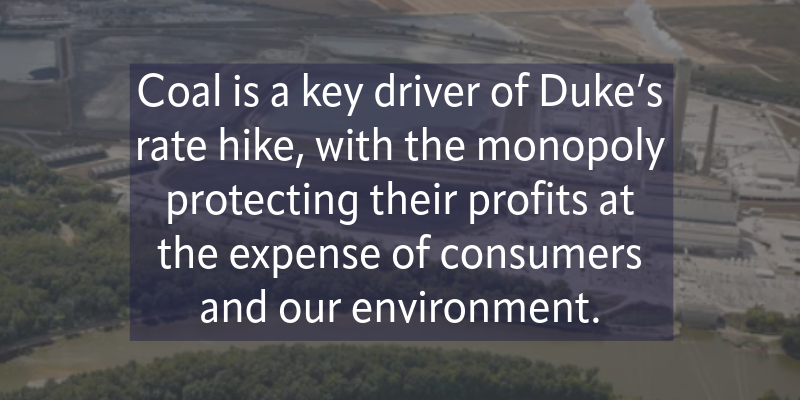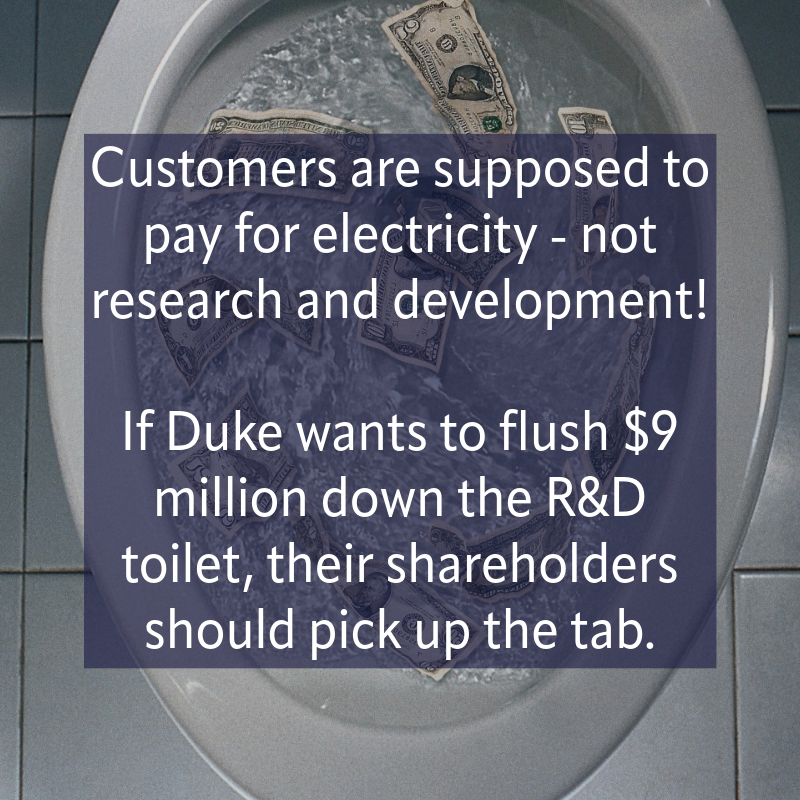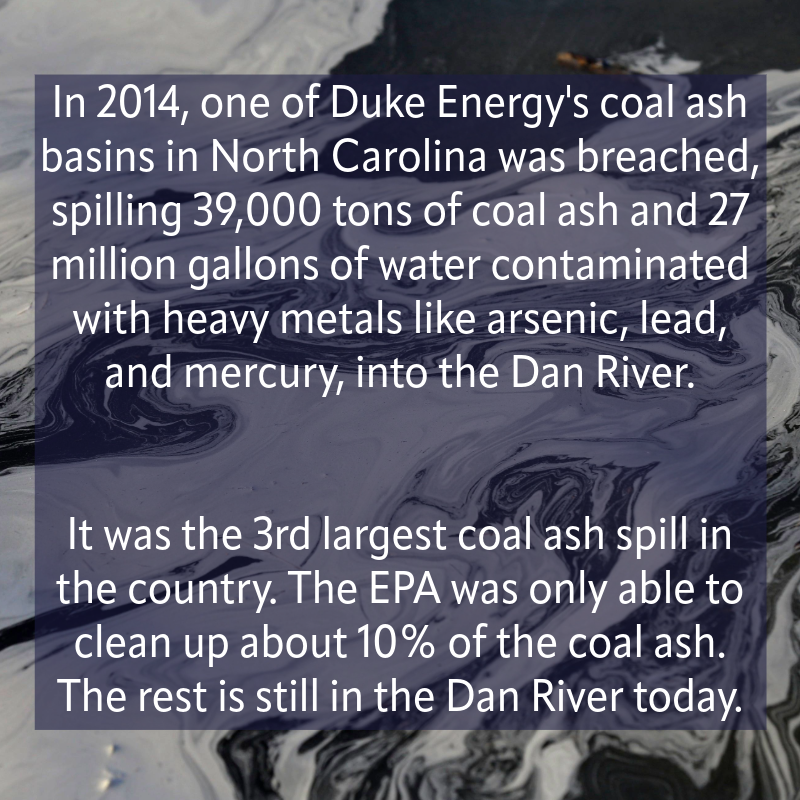Duke Energy Rate Hike (2024)
In April 2024, Duke Energy filed for a massive rate hike in Cause Number 46038 before the Indiana Utility Regulatory Commission (IURC).
Updates
JANUARY 2025 UPDATE: The IURC approved a rate hike of $19.16 per month. Overall, the IURC approved about half of what Duke initially requested. However, the IURC did this in part by spreading out cost recovery of certain items over a longer period of time, which delays the impact to customers rather than permanently reducing it.
A second portion of the rate increase will hit your bills in early 2026. We don’t have exact estimates for the amount of that increase yet, but we expect it to be small, since a bulk of Duke’s rate hike is recovered in Step One.
Specifically, the IURC:
-
Approved a $244.1 million (8.04%) increase in Duke Energy’s annual revenue requirement. Duke originally requested a $491.5 million (16.20%) increase.
-
Approved an increase in Duke’s ROE/profit, from 9.7% to 9.75%. It is disappointing that the Commission increased Duke’s profit margin, although Duke initially requested a 10.5% ROE.
Although CAC is disappointed in the large rate increase, we won on several critical issues that significantly reduced the overall rate increase to Hoosier ratepayers. The IURC denied Duke’s requests to charge you:
-
$92 million in coal ash costs incurred in 2019-2021
-
$1.9 million in annual expenses associated with private jets used by Duke executives. CAC was the only party to testify on this issue, and thanks to our advocacy, this is the first time we are aware of that the IURC denied cost recovery for this type of cst
-
$2.5 million in residential and small commercial rate increases that Duke claimed was needed to address a reduction in revenues it thought might happen from customers switching to new time-of-use rate option
-
For costs associated with stockpiling too much coal in the future
The IURC rejected the following CAC proposals:
-
Stopping Duke’s uneconomic operations of its Edwardsport power plant using gasified coal instead of natural gas
-
Making Duke clean up its coal ash in a safe manner and having its shareholders pay to clean up these risky messes that it caused.
-
Forcing Duke shareholders to pay for the costs of trade association dues and the costs of this rate case (such as the costs of its outside attorneys and expert witnesses).
-
Eliminating card payment fees (surcharges you pay when you make a bill payment using a credit card).
-
Reducing, pausing, or eliminating late payment fees and reconnection fees.
-
Making non-residential customers pay their fair share of costs.
-
Improving residential customer rate design by not increasing the fixed charge, eliminating the declining block rates, and conducting a study to examine the possibility of creating a multi-family rate in the future.
-
Creating a new, fairer policy for providing customers with a fair credit for sharing extra electricity generated by on-premise solar panels with other customers.
-
Passing on the costs of an expensive study that will examine adding carbon capture and sequestration technology at the Edwardsport power plant.
-
Creating a new Affordable Power Rider to provide bill discounts to income-qualified customers and help make electric bills more affordable for customers with the greatest affordability challenges.
JULY 2024 UPDATE: CAC filed testimony in the Duke rate case, making numerous recommendations to the IURC intended to mitigate the impact of this obscene proposal on captive ratepayers.
CAC's recommendations include that the IURC do the following:
- Reduce Duke’s authorized Return on Equity (ROE), or profit
- Reduce or eliminate punitive charges and fees such as deposits, late fees, reconnection charges, and payment transaction charges.
- Prohibit Duke from charging customers for costs related to Gulfstream jets and a private helicopter for executive travel, utility association membership dues that primarily benefit shareholders, filing and litigating this rate case, unidentified economic development projects, corporate restructuring, studying carbon capture and storage (CCS) at the Edwardsport IGCC boondoggle, certain proposals regarding coal ash, and alleged lost revenues resulting from implementation of voluntary Time-Of-Use (“TOU”) rates.
- Deny Duke’s proposal to raise the monthly fixed charge.
- Deny Duke’s request to continue using declining block rates and instead, order Duke to replace those rates with a flat per-kWh rate.
- Require that Duke establish a Residential Affordable Power Rider to provide immediate direct bill-assistance to low-income and vulnerable households.
- Impose a temporary moratorium on disconnections to allow time for Duke and interested stakeholders to establish and implement affordability and health/safety measures.
- Direct Duke to develop a new Distributed Generation (“DG”) Tariff to address existing barriers that consumers face in installing and benefiting from rooftop solar and other DG technologies.
What Duke Wants in this Rate Hike
 Duke Energy is the largest electric utility in Indiana, and its parent company is one of the largest energy holding companies in the United States. The Charlotte based Fortune 150 company raked in over $2.87 billion in profit last year and has 10 million electric and gas customers in 7 states. Duke Energy Indiana raked in $497 million in profit in 2023, and more than $2.7 billion in total profit from 2017 to 2023. Clearly, this large monopoly utility is not hurting for profit.
Duke Energy is the largest electric utility in Indiana, and its parent company is one of the largest energy holding companies in the United States. The Charlotte based Fortune 150 company raked in over $2.87 billion in profit last year and has 10 million electric and gas customers in 7 states. Duke Energy Indiana raked in $497 million in profit in 2023, and more than $2.7 billion in total profit from 2017 to 2023. Clearly, this large monopoly utility is not hurting for profit.
In contrast, significant increases in the cost of housing, food, and healthcare force Hoosier households to make tough decisions daily. It is immoral and unjust that Duke is requesting such a dramatic increase as so many of their customers struggle to make ends meet.
In this case, Cause Number 46038, Duke wants:
- To collect $500 MILLION more from their customers every year. Duke is requesting a 16.2% increase in its annual revenue requirement. If approved, Duke will collect $3.5 billion annually from their Indiana customers - residential (households), commercial (big retailers), and industrial (large manufacturers).
- The highest profit margin out of all electric utilities in Indiana. Duke wants to increase their profit (return on equity, ROE) from 9.7% to 10.5%. Right now, 4 of Indiana’s big utilities have ROEs under 10%, and only one has a profit margin above 10% (CenterPoint at 10.4%).
- To increase your fixed monthly charge from $10.54 to $13.70, a 29.9% increase. The fixed charge is the fee you pay every single month regardless of how much energy you use.
- To continue using declining block rates, a regressive rate structure that forces those who use the least energy to pay the highest rates per kilowatt hour.
High fixed charges and declining block rates disproportionately impact low- and fixed-income households (seniors, people with disabilities, households with children, and other vulnerable populations). They also penalize households that conserve energy and make their homes more efficient.
(Click on the image above to view the spreadsheet.)
Campaign Tools
Submit your comments: Tell the Office of Utility Consumer Counselor (OUCC) to oppose the Duke Energy rate hike. Be sure to reference Cause Number 46038. We want to send out a big thank you to everybody who came to our town hall on June 13th in Bloomington! If you weren't able to join us, below is the video we recorded. You can find the slides from the Bloomington town hall in PDF format here. We want to send out a big THANK YOU to everyone who joined us for our town hall on July 30th in New Albany! We had some technical difficulties with our recording of the town hall, so we're not sure if we'll be able to post it or not. You can find the slides from the New Albany town hall in PDF format here. Public Field Hearings There were four public field hearings about this rate hike. We'd like to send out a heartfelt THANK YOU to everyone who attended the field hearings and spoke to utility regulators about how this rate hike will affect you and your loved ones. The first was in Terre Haute on June 4th. You can find the video from that field hearing here. The second was in Bloomington on June 20th. You can find the video from that field hearing here. The third was in Fishers on June 27th. You can find the video from that field hearing here. The fourth was in New Albany on August 8th. You can find the video from that field hearing here. Check out our May 2024 webinar about Duke's rate hike: Click here to view the PDF slides that go along with the webinar presentation. Help us fight for Hoosiers! Dirty Duke Doubles Down on Coal Duke is already Indiana’s biggest slacker when it comes to the energy transition, with almost 90% of their electricity coming from fossil fuels. Coal is a key driver of Duke’s rate hike, with the monopoly protecting their profits at the expense of consumers and our environment. This is especially true when it comes to coal ash - a toxic byproduct of using coal for electricity. For decades, Duke has been improperly disposing of coal ash by dumping it in unlined pits at their power plants. This toxic sludge, which contains neurotoxins like arsenic and lead, is already leaching into our groundwater and much of it sits next to critical waterways like the White, Wabash, and Ohio rivers. With this rate case, Duke wants to shove decades of coal ash clean up costs onto their customers. Duke is asking for a whopping $223.5 MILLION for coal ash clean up costs, including $92 million in costs that the Court of Appeals previously told Duke they couldn’t collect from customers. Duke didn’t like that, so they successfully lobbied at the Statehouse for SEA 9 (2023) to enable them to charge customers for it. Truly unparalleled greed. Making matters worse, this $223.5 million doesn’t even cover ALL of Duke’s coal ash clean up costs. Duke had a separate coal ash case approved by state utility regulators in May 2024 to the tune of $327 MILLION, and has had millions of other coal ash closure costs approved by the IURC prior to that. The Bottom Line: The quicker Duke reduces its coal consumption, the quicker we can lower costs - and risks to our health and our environment - associated with coal ash. The more coal Duke burns, the higher our bills. That’s why it’s deeply concerning to see Duke double down on coal in a number of ways with this rate case, including: Adding insult to injury, Duke also wants $9 MILLION to study carbon capture and sequestration at the already expensive, inefficient, and scandal ridden Edwardsport power plant. Over a decade ago, Duke studied a slightly different version of CCS at Edwardsport. At that point, CCS would have increased the plant’s construction cost by 37% and decreased its energy output by 20%. ![]()
![]()
![]()
![]()
![]()
![]()







